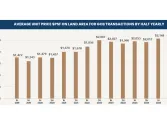The New Normal: how digital forces will upend banking in Asia
By Rupert NaylorIn the past 12 months, we witnessed a range of companies racing to qualify for a spot among Singapore’s first digital banks, mirroring what happened with Hong Kong’s virtual bank licenses the year before. The sense of urgency is understandable - the nature of what it means to be a bank is changing, and this shift is opening a gap in which newer operators can assert themselves. The importance of this is underscored by the fact that the Asia Pacific region has an astonishing share of the world's digitally native population; in markets like India, Vietnam and Thailand, it’s common to become "digitally banked" without having had a credit card – or even a bank account. While Asia Pacific is diverse in its financial systems, there are some unifying factors which are going to change the face of banking across the region.
Here's what we see as the most important ones:
Keeping an Open Mind: Financial institutions take a contemporary approach to open banking
Open banking is catalyzing systemic and far-reaching change across the global financial services industry. Banks have responded by shifting away from the traditional approach to innovation that starts with the legacy technology stack, to a consumer-focused approach based on design thinking that enables more rapid innovation - failing fast where necessary. In Asia, where speed-to-market is absolutely critical, we’re also seeing a greater willingness amongst banks to partner with industry players to accelerate innovation. DBS's Developers API Hub is a prime example of how Singapore is leading the way.
In addition to stimulating innovation and competition, open banking is also building a collaborative ecosystem in which consumer consent drives the sharing of data between financial institutions and fintechs, while enabling benefits for those consumers. And this is where we see a monumental shift taking place. The most successful players will be those who deliver the greatest value to consumers in the form of superior products, services and by using their personal data responsibly.
For consumers, technology has transformed their expectations across multiple dimensions ranging from bespoke offers and rewards, to the convenience of digital experiences, to how products and services should be tailored to their personal preferences. It is these ever-higher standards and increasing expectations that are driving the innovation race.
Cat and Mouse Game: How banks are keeping hardworking cybercriminals at bay
More than half of the companies in Asia Pacific have experienced a cybersecurity breach or are unaware if one has taken place at all – leading to potential economic losses of US$1.745t across the region.
With most parts of Asia being mobile-first markets, banks are racing to make superior digital banking solutions. The proliferation of wallets and the introduction of open banking in various formats will accelerate this trend. While these devices open up a huge vector for cyberattacks, banks need to invest in cutting-edge technologies that include device binding and behavioral biometrics to keep their consumer interactions safe and secure. As risks mount, banks are developing comprehensive cybersecurity strategies that proactively protect consumer data. In Southeast Asia, where one data breach can cost a company an average of US$2.62m (S$3.56m), failure to act can cause long-term damage to a bank’s finances and reputation.
Efficient and effective cybersecurity strategies should be contextually embedded at every level of an institution and at the outset of any new offering. Additionally, risk quantification and action prioritization will help banks maximize the return on cybersecurity investments.
Cashless is King? How going cashless drives financial inclusion and inclusive growth
In Southeast Asia, nearly three-quarters of adults don't have a formal bank account, while 33% of businesses in the region lack proper financing to grow their businesses and plan for the future. At the same time, Asia Pacific’s payments market is on track to grow to twice the size of any other regional payments market in the world, with digital banks and fintechs helping to lower the barriers to financial inclusion and mobile payments becoming more accessible.
Victory in the digital banking/fintech battle will ultimately be decided by players’ ability to foster financial inclusion, rather than continuous technological advancement. Once these businesses have captured large portions of more technologically sophisticated consumers, they will have to expand outwards, rather than upwards, and that will mean gaining a greater understanding of the needs of populations who are far removed from any kind of formal banking system. The incentives need to be clear for these prospective customers to make the jump into an ecosystem which is truly foreign to them, but for those companies that are able to connect these dots, the potential payoffs are substantial - both for the businesses themselves, and for the broader economy.



















 Advertise
Advertise










